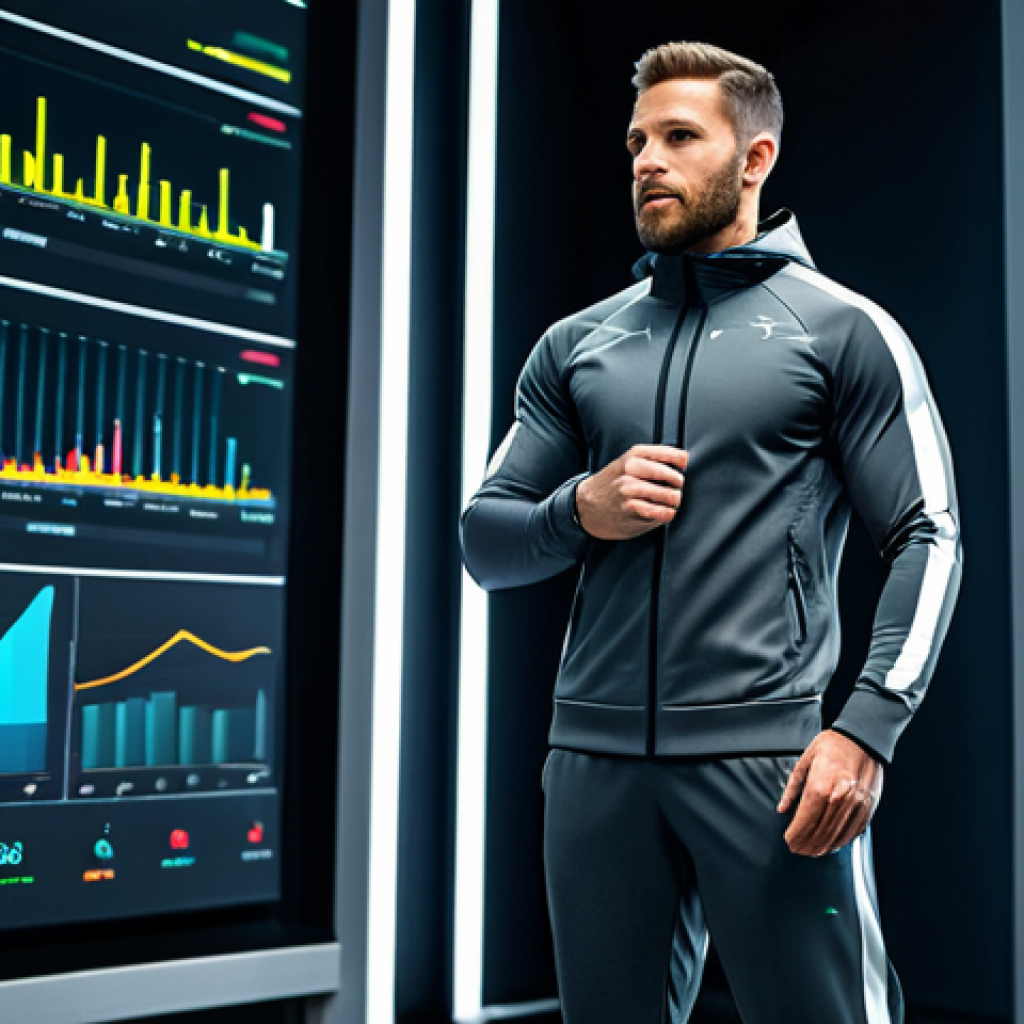Remember those days when your training log was a scrawled notebook, or you just guessed at your progress? I certainly do. It was honestly frustrating, trying to optimize my striking or grappling without real-time feedback or a clear, adaptive path forward.
The sheer dedication combat sports demand, whether you’re into Muay Thai, BJJ, or boxing, often feels unsupported by traditional methods in today’s demanding world.
But here’s the game-changer I’ve personally experienced: the right digital companion. We’re moving beyond simple timers; the cutting edge now incorporates AI-driven feedback, personalized workout generation based on your actual performance, and even injury prevention protocols that were once only available to elite athletes.
Imagine a virtual coach in your pocket, adapting to your every jab and takedown attempt, ensuring every sweat-soaked session truly counts. This isn’t just about convenience; it’s about unlocking a new level of potential and staying ahead of the curve in a sport that constantly evolves.
Let’s find out exactly how this revolutionary approach can transform your training.
The Adaptive Coach in Your Pocket: AI-Driven Personalization
This is where the real magic happens, I’ve found. Gone are the days when you’re stuck following a generic workout plan, hoping it aligns with your unique strengths and weaknesses.
I remember feeling so frustrated, constantly wondering if I was doing the right drills or if my training was truly optimized for *my* body and *my* specific goals.
It felt like I was just throwing darts in the dark, hoping to hit the bullseye. But then, I started exploring apps that leverage AI, and it was a complete revelation.
These aren’t just glorified timers; they are sophisticated systems that analyze your actual performance data – your punch speed, your accuracy, your reaction time, even your heart rate variability – and then dynamically adjust your training regimen.
Imagine having a personal coach who watches your every move, understands your fatigue levels, and immediately suggests a modification to a drill or a different strategy for your next round.
It’s like they truly get you, adapting to whether you need more explosive power for a knockout punch or more endurance for sustained grappling. This level of personalized feedback makes every single session exponentially more effective and, honestly, more enjoyable because you feel seen and supported.
I’ve noticed a drastic improvement in my consistency and overall skill set since adopting this approach, and it truly feels like I’m finally unlocking my full potential, session by session.
1. Dynamic Drill Adjustments Based on Real-Time Performance
One of the most impactful features I’ve personally experienced is the ability of these AI platforms to tweak my drills mid-session. For instance, if I’m working on my jab-cross combination, and the app detects a slight drop in my cross’s power or accuracy after a few rounds, it won’t just let me keep grinding away inefficiently.
Instead, it might suggest focusing specifically on hip rotation for the next set, or perhaps slowing down the drill to emphasize form over speed, or even recommend a short active recovery period before resuming.
This immediate, data-driven feedback loop is something I never got from my old, static workout sheets. It feels incredibly responsive, almost as if an experienced coach is right there, correcting my form or pushing me just enough without risking overtraining.
It’s not just about pointing out flaws; it’s about providing actionable, personalized solutions on the fly, which has dramatically accelerated my learning curve and minimized the development of bad habits.
This adaptive nature makes every single minute of training count, and for someone with a busy schedule, that efficiency is gold.
2. Tailored Progressive Overload and Skill Development
Another aspect that truly transformed my journey is how these AI coaches manage progressive overload and skill development. It’s no longer about arbitrarily adding more reps or rounds.
Instead, the AI intelligently analyzes my progress across different metrics – power, speed, technique, endurance – and then constructs a training plan that ensures I’m consistently challenged but never overwhelmed.
For example, if my defensive head movement is lagging, the system will subtly incorporate more specific drills for that area into my routine, gradually increasing the complexity and intensity as I improve.
If my cardio is strong, it might push me with more high-intensity intervals. This tailored progression means I’m always working on what matters most for *my* current level and *my* specific goals, whether I’m prepping for a competition or just trying to stay in peak physical condition.
It removes the guesswork from progression and ensures that every step forward is a calculated and effective one, keeping me motivated and seeing tangible results week after week.
Beyond the Gym: Unleashing Data-Powered Performance Metrics
I used to rely on my gut feeling, or maybe a quick video review, to assess my performance. But honestly, how much can you really tell from a shaky phone recording or just “feeling” strong?
It’s astonishing how much more insight you gain when you integrate precise data analytics into your combat sports training. This isn’t just about showing off fancy numbers; it’s about identifying true strengths, uncovering hidden weaknesses, and making informed decisions about where to focus your energy for maximum impact.
I’ve personally experienced the profound shift from subjective assessment to objective, measurable progress, and it’s a game-changer. Suddenly, you’re not just throwing punches; you’re throwing punches at X speed with Y power and Z accuracy, and you can track these metrics over time, seeing undeniable trends.
This level of detail has allowed me to fine-tune my technique in ways I never thought possible, giving me a competitive edge and a clearer path to improvement.
It transforms training from a series of exhausting sessions into a strategic, data-driven campaign where every input is designed to yield a specific, measurable output.
1. Pinpointing Weaknesses with Unflinching Precision
One of the most frustrating aspects of training used to be knowing I wasn’t perfect but not exactly knowing *why* or *where* to fix things. These analytical tools have a way of putting your weaknesses under a microscope.
For example, an app might show me that while my right hook generates excellent power, its setup time is consistently slower than my left, making it more predictable.
Or perhaps my defensive slips are effective 80% of the time, but only against straight punches, leaving me vulnerable to hooks. This kind of granular data is priceless.
It removes all doubt and guesswork, presenting you with undeniable evidence of areas that need attention. I remember one specific instance where I thought my head movement was solid, only for the data to reveal I was consistently leaning into my opponent’s power side during certain combinations.
That’s a critical flaw that’s almost impossible to spot with the naked eye in real-time, but the data flagged it instantly. This allowed me to immediately adjust my drills and focus on correcting that specific, dangerous habit, potentially saving me from future concussions in sparring.
2. Visualizing Progress and Celebrating Milestones
There’s something incredibly motivating about seeing your progress quantified and visualized. Forget the vague feeling of “getting better”; imagine seeing a graph that shows your average punch speed increasing by 5% over two weeks, or your reaction time decreasing consistently over a month.
These performance metrics aren’t just raw numbers; they’re often presented in intuitive dashboards, complete with charts, graphs, and heat maps that highlight your improvements and identify plateaus.
This visual feedback has been a huge psychological boost for me. On days when I felt fatigued or unmotivated, looking back at tangible proof of my hard work and improvement was enough to reignite my drive.
It also helps in setting more realistic and challenging goals. Knowing I increased my grappling transition speed by 10% last month makes me confident in aiming for another 8% next month.
It turns training into a measurable journey of continuous improvement, where every small win is celebrated, and every plateau becomes an opportunity for a strategic adjustment, ensuring I stay on track towards my ultimate goals.
| Metric Type | Example Metrics Tracked | Impact on Training |
|---|---|---|
| Striking Performance | Punch Speed (MPH/KPH), Punch Power (Force), Accuracy (Target Hits), Reaction Time | Identifies power imbalances, improves precision, hones defensive reflexes. |
| Grappling Efficiency | Transition Speed, Submission Attempt Success Rate, Escape Time, Positional Control Time | Optimizes flow, refines technique, enhances control and escapes. |
| Physical Conditioning | Heart Rate Zones, Calorie Burn, Recovery Rate (HRV), Endurance Metrics | Manages fatigue, prevents overtraining, optimizes cardio and stamina. |
| Technical Proficiency | Form Consistency, Movement Efficiency, Balance Stability, Footwork Patterns | Corrects bad habits, builds solid fundamentals, enhances overall fluidity. |
Forging Mental Resilience: Visualization and Strategic Play
It’s easy to focus solely on the physical grind in combat sports. We spend hours perfecting our jabs, our takedowns, our submissions. But anyone who’s truly stepped into the ring or onto the mat knows that the fight is won or lost as much in the mind as it is with the body.
I used to struggle immensely with pre-fight nerves, or even just moments of doubt during a tough sparring session when I felt overwhelmed. My physical skills were there, but my mental game sometimes felt like a flimsy shield.
That’s when I realized the critical role that dedicated mental training plays, and how modern apps are making it accessible in ways I never imagined. These tools aren’t just about feeling good; they’re about building steel-like focus, unshakeable confidence, and the ability to visualize success even in the most challenging scenarios.
It’s about cultivating the mental fortitude that allows you to execute your game plan under pressure, adapt on the fly, and truly believe in your capacity to overcome.
This has been a profoundly transformative journey for me, as I’ve learned to harness my mind as much as my muscles.
1. Mastering Pre-Fight Nerves Through Visualization Techniques
I’ve always been someone who gets a bit jittery before a big session or any sort of performance. In combat sports, those jitters can easily turn into paralysis or frantic, inefficient movements.
I discovered that many of these advanced training apps include guided visualization exercises specifically tailored for athletes. Instead of just thinking about winning, these modules guide you through meticulously detailed scenarios: walking out, hearing the crowd, feeling the mat under your feet, executing your strategy flawlessly, and even reacting calmly to unexpected challenges.
I spend 10-15 minutes before my training sessions, sometimes even before important meetings outside of the gym, just going through these visualizations.
It’s uncanny how much it calms my nervous system and primes my mind. When I actually step into the ring, many of those movements and reactions feel almost familiar, as if I’ve already done them a hundred times.
This reduces the mental load and allows me to react instinctively, rather than getting caught up in self-doubt or anxiety. It’s a powerful tool for building psychological rehearsal and ensuring that my mind is as prepared as my body for whatever comes.
2. Strategic Scenario Planning and Game Theory Applications
Beyond just visualization, some of the more sophisticated apps actually integrate elements of strategic scenario planning, almost like a combat sports version of chess.
They present you with various in-fight situations – perhaps you’re on your back in BJJ, or you’ve been tagged with a solid jab in boxing – and prompt you to think through your immediate reactions and follow-up strategies.
They might even use AI to simulate an opponent’s common responses. This kind of active, cognitive training is brilliant because it forces you to think several steps ahead, considering multiple possibilities and counter-strategies.
I’ve found this invaluable for developing my in-fight problem-solving skills. Instead of just reacting instinctively, I’m learning to react *strategically*.
It’s not just about drills; it’s about understanding the “why” behind every move and anticipating potential outcomes. This has made me a much more intelligent fighter, someone who can adapt and implement a viable game plan even when things aren’t going perfectly.
It’s truly elevated my understanding of the sport beyond just physical execution.
Smarter Training, Safer Athletes: Injury Prevention & Optimized Recovery
Anyone who’s been in combat sports for a while knows that injuries aren’t just an inconvenience; they can derail your entire progress, crush your morale, and even force you to reconsider your passion.
I’ve had my fair share of bumps and bruises, and a few more serious setbacks that took me out of training for weeks. It was incredibly frustrating to feel like I was constantly on the verge of injury, or that my recovery was haphazard.
But now, with the advent of smart training tools, the focus has dramatically shifted from merely reacting to injuries to proactively preventing them and optimizing recovery.
This isn’t just about avoiding pain; it’s about building a more resilient body and ensuring longevity in a demanding sport. I’ve personally felt a profound difference in how my body recovers and how much more confidently I can push myself, knowing that an intelligent system is helping me monitor my limits and guide my restorative practices.
It’s truly about training smarter, not just harder, and preserving your body for the long haul.
1. AI-Driven Fatigue Monitoring and Overtraining Alerts
This feature has been an absolute lifesaver for me. In the past, I’d often push myself to the brink, sometimes even past it, because I was so driven to improve.
I’d confuse soreness with progress and end up overtraining, which invariably led to diminished performance, increased irritability, and eventually, some sort of strain or nagging injury.
Now, my training app, often linked to a wearable device, constantly monitors my heart rate variability (HRV), sleep patterns, and daily activity levels.
If my HRV drops significantly, or if I’ve had a few consecutive nights of poor sleep, the AI will issue an alert and suggest a lighter training day, a full rest day, or a session focused solely on mobility and recovery.
It’s almost like having a highly sensitive internal barometer that tells you exactly when to ease off the gas. This proactive approach has dramatically reduced my incidence of minor injuries and completely eliminated the feeling of “hitting a wall” due to overtraining.
It empowers me to listen to my body in a scientific way, ensuring I get the most out of every training session without pushing myself into the danger zone.
2. Personalized Recovery Protocols and Mobility Routines
Beyond just preventing overtraining, these intelligent systems also provide tailored recovery and mobility protocols. It’s not a generic stretching routine; it’s a personalized set of exercises designed to address your specific needs based on your training load and any detected muscle imbalances or tightness.
For instance, after a particularly intense grappling session, my app might recommend specific hip mobility drills and targeted stretches for my lower back and hamstrings, all complete with guided videos.
If I’ve focused heavily on striking, it might suggest shoulder and wrist mobility exercises. These routines are dynamic, adapting to my weekly training volume and helping me actively mitigate the common aches and pains that come with hard training.
I used to just do some vague stretches or foam rolling, but having a structured, personalized recovery plan has made a massive difference in how quickly I bounce back and how fluid I feel in my movements.
It’s like having a dedicated physical therapist prescribing my daily recovery, ensuring that my body is always ready for the next challenge.
The Global Mat: Connecting, Competing, and Learning Across Borders
Combat sports can sometimes feel like a solitary journey, even within a gym. You train with your partners, but the world of martial arts is vast and diverse.
I used to feel a bit isolated, confined to the techniques and perspectives available in my local academy. But this digital revolution has completely opened up the landscape, creating a global community where insights, challenges, and support flow freely across geographical boundaries.
It’s no longer just about who you train with in your local area; it’s about tapping into a worldwide network of practitioners, coaches, and enthusiasts.
This expansion of my network has been incredibly enriching, broadening my perspective and offering new avenues for growth and motivation. It’s added a whole new dimension to my training, making it feel less like a solitary pursuit and more like being part of a vibrant, interconnected global family.
The sense of camaraderie and shared passion, even with people thousands of miles away, is genuinely inspiring.
1. Virtual Sparring and Online Challenges for Competitive Edge
One of the most exciting developments I’ve witnessed is the rise of virtual sparring and online challenges. While it doesn’t replace the physical contact of live sparring, these platforms offer unique opportunities to sharpen your skills.
Imagine being able to set up a virtual sparring session where you execute combinations or defensive movements, and an AI opponent reacts in real-time, or you engage in a timed challenge against a recorded performance of a top athlete from another country.
These are incredibly engaging and push you beyond your comfort zone. I’ve participated in online challenges where I had to hit certain targets with specific power and speed, or perform a complex grappling transition under a time limit, and then compared my performance against others globally.
This has not only added a fun, competitive element to my solo training but also exposed me to different styles and strategies that I might never encounter in my local gym.
It’s a fantastic way to test your skills against a broader benchmark and stay sharp even when you don’t have a live training partner available.
2. Accessing Diverse Coaching and Community Knowledge
Perhaps even more valuable than virtual sparring is the unprecedented access to diverse coaching methodologies and community knowledge that these platforms provide.
I’ve joined online forums and groups within these apps where professional coaches from different countries share drills, technique breakdowns, and strategic insights.
It’s an absolute treasure trove of information. I’ve learned new setups for submissions from a BJJ black belt in Brazil, refined my Muay Thai clinching based on tips from a trainer in Thailand, and even picked up nuanced defensive footwork from a boxing coach in the UK.
This kind of cross-pollination of ideas was almost impossible just a few years ago. Furthermore, being part of these global communities provides immense motivation.
You see others sharing their progress, asking insightful questions, and offering encouragement, and it fosters a genuine sense of belonging. It’s an empowering environment where knowledge is democratized, allowing everyone, regardless of their location, to learn from the best and continually evolve their understanding and application of their chosen martial art.
Your Future Self: Real-Time Feedback and Predictive Insights
The leap from post-training analysis to real-time feedback has been nothing short of revolutionary for my training. There’s a world of difference between reviewing a video of your performance hours later, trying to recall how you felt in the moment, and getting instant, actionable insights as you’re throwing a punch or transitioning into a sweep.
This immediacy is incredibly powerful because it allows for instantaneous adjustments, cementing good habits and correcting flaws before they even have a chance to take root.
I’ve experienced firsthand how this “now” feedback accelerates learning and refines technique at an astonishing pace. It’s like having a hyper-attentive coach constantly whispering corrections and affirmations directly into your ear.
But it doesn’t stop there; the truly cutting-edge tools are now venturing into predictive insights, helping you anticipate future performance and potential issues, essentially giving you a crystal ball for your training journey.
This forward-looking capability is truly what sets apart the elite digital companions, preparing you not just for the next session, but for your long-term success.
1. Instantaneous Form Correction and Technique Refinement
This is where the direct impact on my technique became glaringly obvious. I use sensors – sometimes embedded in my gloves, sometimes worn on my body – that connect directly to an app providing real-time audio or visual feedback.
For example, when practicing my straight punches, if my elbow flares out too wide or my wrist isn’t perfectly aligned upon impact, the app immediately alerts me.
It might say, “Elbow in!” or “Snap that wrist!” It’s not just a general correction; it’s precise feedback on the exact point of error. This immediate correction loop is so much more effective than waiting until after a round to review footage.
By getting instant feedback, I can adjust my body mechanics within the same breath, reinforcing the correct movement pattern right away. I’ve noticed a significant improvement in my striking efficiency and power simply because I’m able to course-correct in the moment, preventing bad habits from becoming ingrained.
It’s like having a master technician constantly overseeing every single repetition, ensuring peak form.
2. Predictive Analytics for Peak Performance and Strategic Planning
Beyond reactive feedback, the more advanced platforms are integrating predictive analytics, and this is truly exciting. Based on your historical training data, current performance metrics, recovery status, and even external factors like sleep quality and nutrition input, these AI models can begin to forecast your readiness for peak performance.
It might suggest, for instance, that you’re optimally primed for a heavy sparring session on a particular day next week, or conversely, that a lighter, technical day would be more beneficial to avoid burnout.
I’ve used this to schedule my most intense training days strategically, ensuring I hit my maximum potential when it matters most, whether for an important spar or just a particularly challenging drill.
Furthermore, some tools can even predict potential points of failure or areas where you might plateau based on your progress trends, allowing you to proactively adjust your training plan to mitigate these issues before they arise.
This foresight is invaluable, transforming training from a reactive process into a highly strategic and optimized path towards consistent improvement and sustained peak performance.
Conclusion
Stepping back and looking at my journey, it’s clear that AI-driven tools have revolutionized my approach to combat sports. What once felt like a shot in the dark has become a precise, data-backed expedition towards mastery. From dynamically adjusting my drills in real-time to sharpening my mental game and even preventing injuries, these intelligent companions have elevated every facet of my training. It’s not just about getting stronger or faster; it’s about training smarter, safer, and with an unprecedented level of insight and connection. If you’re serious about unlocking your full potential and staying ahead of the curve in this demanding discipline, embracing these technological advancements isn’t just an option—it’s the future.
Useful Information
1. Define Your Goals First: Before diving into any AI training platform, clarify what you want to achieve. Are you aiming for competitive improvement, general fitness, or injury recovery? Your goals will help you choose the right app and features.
2. Research Compatibility: Ensure any AI-driven app or wearable device you consider is compatible with your specific combat sport. Some are tailored for striking, others for grappling, and some offer broader, integrated solutions.
3. Integrate, Don’t Replace: Remember, AI tools are powerful enhancements, not substitutes for a good human coach. Combine their insights with professional guidance from your gym to get the most well-rounded development.
4. Start Gradually with Data: Don’t get overwhelmed by all the metrics. Pick a few key performance indicators (KPIs) relevant to your current focus, track them consistently, and gradually expand as you become more comfortable with the data.
5. Prioritize Data Privacy: As these systems collect personal performance and biometric data, take a moment to understand the app’s privacy policy. Ensure your information is secure and used ethically.
Key Takeaways
AI-driven personalization optimizes every training session, adapting to your unique needs.
Objective data analytics pinpoint weaknesses and track progress with precision, eliminating guesswork.
Dedicated mental training tools build resilience, focus, and strategic thinking for in-fight scenarios.
Smart monitoring and personalized recovery protocols significantly reduce injury risk and accelerate healing.
Global online communities offer unparalleled access to diverse coaching and competitive challenges.
Real-time feedback and predictive insights accelerate skill acquisition and strategic long-term planning.
Frequently Asked Questions (FAQ) 📖
Q: So, how exactly does this
A: I-driven feedback go beyond just a basic fitness tracker or my old-school paper log? I’ve tried apps before and they mostly just count reps. A1: That’s a fair question, and one I wrestled with myself!
For years, my training log was a mess of illegible notes and vague memories. “Did 5 rounds, felt good.” What does “felt good” even mean for progress? And those basic trackers?
Yeah, they’re fine for steps, but they don’t understand your sport. The real difference with this AI isn’t just data collection; it’s interpretation and adaptation.
I remember hitting a wall with my boxing, feeling stuck, and my traditional coach could only give so much one-on-one time. This digital companion, though?
It watches your actual performance – your punch speed, your takedown execution, your reaction time – and then, almost instantly, it breaks down why you’re struggling with that hook, or why your sprawl isn’t effective.
It’s like having a dedicated analysis team, not just a glorified stopwatch. It learns you, identifying subtle patterns in your fatigue or technique breakdown that you’d never spot yourself, and then tailors your next session to specifically address those weaknesses.
It’s not just “do 10 more push-ups”; it’s “let’s refine your hip escape angle because we saw a dip in your efficiency after round three.” That’s the personalized, game-changing insight I’ve personally experienced.
Q: I’m not looking to turn pro, I just love my weekly BJJ or Muay Thai classes for fitness and fun. Is this kind of revolutionary tech really for someone like me, or is it overkill?
A: Absolutely not overkill! And honestly, that was my exact thought process. I’m not gearing up for a title fight, I just want to keep improving, stay healthy, and enjoy my training.
For me, the biggest revelation was how it democratized access to what used to be elite-level insights. Think about it: injury prevention. I’ve had my share of aches and pains from just showing up, right?
This tech can pick up on subtle imbalances or overtraining cues before they become a nagging injury that sidelines you for weeks. It’s about longevity in the sport you love.
Plus, the personalized progression means you’re not just following a generic curriculum; you’re optimizing your specific journey. It keeps things fresh, challenging, and incredibly motivating, even if your goal is just to feel stronger or nail that tricky sweep you’ve been working on.
It’s less about becoming a professional and more about becoming the best, healthiest version of yourself on the mat or in the ring. I’ve found it keeps me so much more engaged than just showing up and hoping for the best.
Q: This sounds incredible, but honestly, what kind of investment are we talking about here, both in terms of money and the learning curve to actually use it?
A: I totally get that concern; new tech can feel like a big leap, especially when you’re already investing time and money into training. My initial thought was, “Is this another gadget that’s going to sit in a drawer after a week?” But what I’ve found is that the monetary investment is surprisingly reasonable, especially when you compare it to the cost of regular private coaching sessions.
We’re often talking about a monthly subscription that’s less than a few coffees a week, maybe a one-time purchase for a high-quality sensor if it’s a hardware-integrated system.
For the value it provides in terms of personalized feedback and injury avoidance, it feels like a steal. And the learning curve? Honestly, it’s designed to be incredibly intuitive.
Most of these apps are built with user experience in mind, so you’re not spending hours poring over a manual. You sync a sensor, open the app, and it walks you through it.
I was up and running within minutes, and the immediate, actionable feedback made it feel instantly worthwhile. It integrates so seamlessly into my existing routine that it’s no longer an ‘extra step,’ but just how I train now.
It’s an investment in smarter training, not just more complicated training.
📚 References
Wikipedia Encyclopedia
구글 검색 결과
구글 검색 결과
구글 검색 결과
구글 검색 결과
구글 검색 결과





